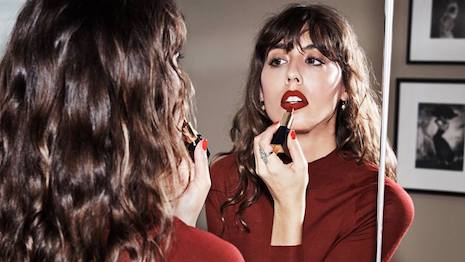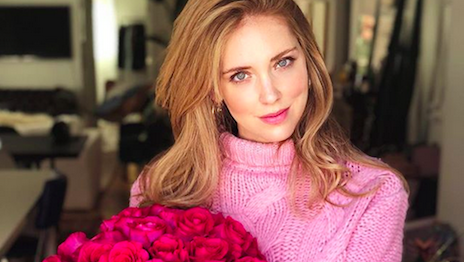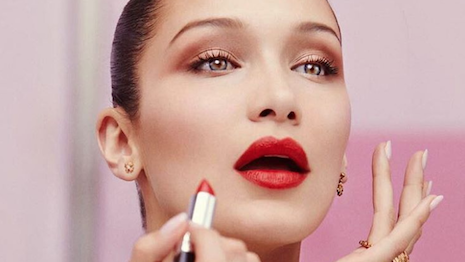Beauty brands are investing more heavily into social media and influencer marketing than their peers in fashion and luxury, according to a new report.
Launchmetrics’ “Beauty Redefined” ebook notes that there has been a 23 percent drop in print advertising value for beauty labels between 2013 and 2017, with the category putting more focus on digital marketing. As the industry sets its sights on millennials, influencers are playing a significant role in driving awareness and engagement for consumers who prefer to research online.
“One of the biggest challenges of beauty brands today is really to amend this notion of tradition to reach the newest generations,” said Arnaud Roy, chief strategy officer at Launchmetrics, New York. “We know that they don’t go so much for magazines or watch TV commercials.”
Social approach
Compared to fashion brands and luxury labels, which spend around 30 percent of their budgets on print advertising, beauty marketers only allocate 4 percent of their budget to print.
Fashion and luxury brands also spend about 40 percent of their budgets on social media, whereas beauty brands’ social media marketing is 85 percent of their total spend.
Influencer marketing is particularly important for beauty brands. On average, influencers make up more than half the voices talking about these labels, whereas they only account for less than a quarter of mentions for fashion and luxury brands.

Estée Lauder's is among the brands leveraging influencers. Image credit: Estée Lauder
"It's always interesting for us to analyze the similarities and differences between the fashion, luxury and beauty industries," said Michael Jaïs, CEO of Launchmetrics, Paris. "In our book, Beauty Redefined, our research shows how this digital savvy section ranks at the top with 80 percent of their marketing activities being powered by social - compared to 40 percent in fashion and luxury.
"Our latest report details the power of influencers in this sector, the voices driving value for brands today and winning strategies brands should adopt for success," he said.
Due to the nature of product use, influencers are less apt to be loyal to a single brand. More so than fashion, they will tend to mention multiple labels in a post or video.
One way to combat this lowered share of voice is by sponsoring the influencer’s content, getting greater awareness and placement. Brands can also seek out influencers with a greater affinity for their products.
While the beauty business is placing a lot of importance on influencer marketing, the types of partnerships that brands enter into varies. More high-end labels tend to show more favor towards influencers with more than 500,000 followers than mass brands, who use a greater share of micro influencers.

Lancôme's has tapped mega influencer Chiara Ferragni as a brand ambassador. Image credit: @chiaraferragni
One type of influencer that is popular in the beauty world is the vlogger. These personalities share content such as unboxing and hauls, tutorials and reviews, and consumers look to them for guidance on purchases.
Despite the rise of Instagram for influencer marketing, YouTube is the frontrunner for beauty blogging when it comes to engagement rates.
Influencer increases
Beauty marketers have been early adopters of digital and influencer marketing, which have now proved to be effective for 98 percent of the industry.
Eighty-four percent of beauty brands have claimed to work with an influencer online in the past year, according to a survey from Celebrity Intelligence. The report says that for every 1 pound, or $1.34 at current exchange, brands earned 8.81 pounds, or $11.81, for an average positive return on investment (see story).
Beyond social media posts, vloggers are gaining places of power in the beauty industry. They are also helping to guide product creation and trends.
For instance, beauty marketer Estée Lauder appointed makeup artist and influencer Violette as its new global beauty director.
In her role, Violette works on developing new products and guide women in finding their beauty look. While from a different generation than the beauty label’s eponymous founder, Violette shares qualities with Estée Lauder such as a sense of individuality and the perspective that beauty is a means of empowerment (see story).
British department store chain Harvey Nichols also worked with bloggers as it embarked on an Arthurian-style quest for the ideal beauty collection.
The retailer launched a five-week content series that searched for the “Holy Grail” across five cosmetic categories with help from five expert ambassadors. The beauty industry is filled with new launches and a seemingly endless array of choices, making this round table an opportunity for consumers to test out products through a personable proxy (see story).
Brands may also want to consider creating experiences to naturally spur influencer content.
"When we think about influencers or how to activate them, the creative part is a really important piece of that," said Yuli Ziv, CEO of the influencer marketing division and co-managing director of USA at Launchmetrics, New York. "It’s not just about the data."
{"ct":"VdnE78uB\/PqEEZa2zJ2ar5tri4OB2lzCvPCCwPx1\/zRtCH5hV\/I3EBEkFg8LxzY7dsM6mu8QZOE+jbUPQFJiSZv1d7nmXdkc\/CUgwdY9BTTrVhkaroirUxRebCl98yaJ+jIH7kdyRvH6nSXBLPbLfhDq6HOmnp+3LC99JRTx7G1GG42oWgzUQko7o\/UYPRtU+8CWnQmwFe6XmhNjO8v7FOwuv0wJftQFD8hC0RF\/+KLLCmNEJEWu57SjPaw606Sg5UUzNogGHEUTybaZjtvhAYnW4h1lX780s\/BO6T9qLKLPD\/OvEBuPqPSyb7g4XfMeyzV738F3tpXcvMpZJFDOYZM67924WkkBcwrcT52QMn8aav2pwzr801k1XfDvQYiqkRZxhFBfMaFNKqo8h2ZBVxq+ZHYTBCgHZR+fXmbdnGyaKYHQ6ZFN8Mp5+UW2DPlzyCQOtR4BRyiTWuloLzAtL3RFfEsX8+Ux9s7MNkhmjx9G9aHqnx3ygusdlAR6anTXZK8wdm5C24UlP7tuhWnQNdULkH9+hafGbgdSv+upVNokhbW8PLuX3u6nH\/anctrSke3Dbx93n8WVFrjXQ+6U0FFx4ZHTGIBeUo4YnqYfiFDOL1gBnUePjS0CYrPwDGIESXxpd0UdpN9Hey4Cuwf1quir36dN4NpmEDgIu0Ga5P7VR8VbShduV8wuIvrNObUa2TPD0zsbKTepRYaA6WGs\/AXhwdjJA4s2eocHUqRPQh\/VqPmEgt8jQsilnRUVfBPcXVST+gQ\/MAC7PP5W20eQX5kVp\/98xpwn0EF6ZAvqsihiy4cWqVmS3WkuCuDzOMlOEAiL8BVNYMDamT5CQOFpYwjyvvSdV6D6zpL1yk5UT3PUz9H278AWjl0eMgA0jBW7Pmi\/5HCdA0mjtku3ewWhCOVt5ARVnwEZ\/Wid8J3aFHMoBnC8cC4jtGrLc6zZjB9Bi1UqmGWm4T96P2cRXIm2rViTE6crfAf4a3VBxsrDaCySgzG5we5VkDkEsSGzBMnkuku96fXHWpb6XWCr42APeSvDKfqdVlbBC3Ri3wnG6M8Hh2HNNfnICctxCShiTQlJoY4orbF+Q9sQ8S8U4+uwSnDCRF8F4y5EJzfaQ0jvfNUXR8shiN6leE\/raPMm6avm4uOOOsWBAEk+Konjjhc+l6juSQAG5DNhROAzPZsFWmTWclkFueMCeqkq1pMQpSEMuPERbJDBXGsKrixamkucTsldTL3rR+F9Zk6jTChUWMzeiUjnZgz31KPARZyPiW71HcaJsM6lp\/4MVoFfHT8U+L+r4XSOGhLSL6RIYBJp5Bi+qxcIGx73XZ\/yJvXQAWQBr9wlMFbEoE3riXJWzm08gYFai6LXz9I791CRu0Z4lMFgRcjVSRQ3nR4c9+qIWII3lXrOJUPpZhmw7fcIwJ0BLBwW3sTnSfLCaaaxw6xGncWnnsd9CM5oxAU\/7a80jBRUahVTaoxaOo8k1aDNnmPT60dupbxCOd5lNFGCdJGub6XIxWwTFL0LZmjRd2z42V344gOoOp2HL6M5vf8Rbg5baSM6mejqtLha0Zy0hdbTwOSOE4sRigM\/Y9obFhn54Z3Izn5e5Z+9yiNi7uRp\/ftvBDy5RMKbvx4R11Koqf\/ahYglZNhRCX1OObnZaRb2RzgNHFw4lKz+rLLzt9oaVwBvVnCSxvWkPnXLQem22U\/HNV2XYadpGWKdUjVzG4MqrpmUXIO5OxxQAY5ULt6xvD5nGRK1pW6dntSRpVlyQLVnLR9yNIO07fw9utXpXVL7H\/fSKdop1H9tO8BD+R8LyYJYRjzpP26urJVyS0xsIYpqqgDgST009UCRw3c9EvTNu+9yEGar\/N5hLwr6IS6\/uK7Q\/w3xj1X5MXj8SacUd6RngaqMv+S3U+g1GTwWD5vOu0wXKhjc0H5u086YDJCKtMyIsKiYWCwZRUv1TjeWj3u7DjDFNV5cAAB49xjKJHM4Vjjq7FHsgnsAkCWcO1oLINKaa2XUE1Bx3SU1QXMYaAkOFcMtG\/IvRSMSRleOfdFt8D2Urb8H9gqSZUzDrjQBaX6od7BgDbRwFbQSh87f92KMEqMnlzHKdC\/j2ZgOOF7hbSTXr26ozutaWd3M9TA1cQRm6shJTlJxF9zK3ykaA43\/VuH0Mm5gm7xwDuzZwgzoGNX+CfpovZmn6Kzy4Us+SugZ0zsdKUFk0BXTOC9h1Ol1hm40lxQ8F8YebaQcDd\/LwbKmzEonSNABSFa6XWtJtt5AosFW9dk\/KwdB66sHts+zSyXtkVaCVjyY23ZJKyJSLxFfRToO94VdZvUDTn9dtIDgx\/Ko4+YVybCqDsGOxN5htb2trw598mfqPFwV8rjyjwDLQhxj5YDp+OXXT361BpAYRUSSJ99kqAR4bz8UEJ\/QdX5iJTyT63AYfmr+4YXOeAHiaZnZI045u57N66Ls5\/WFIISywv22WL\/MjCK7pxlOaAEL5rgaKkx1Xxje0+WhROAfzMivWLsYp0u+wavup1pqAC9azLLTjpbCp+o2pjA21Oyb7DobYnbS0mKlHUSqDs31qU7TigOfkuVnnEwAjCISBGiamr5kg6iwLtsWEwc2sRK1dgovGdtGtJzZX7zoDpj0M9gGv9or31+W\/PCU0Ltg3WENAP8qQgXXoPT+vYNzqNLnju1OTQwMGh1hQ2kvKfsrVMF7YMlG7mygm\/R2HAuW9jXzJ3Ya5bp+dyWvAkKfa74vYF2kcDV\/FpuwdkgKXS80wWtgd+w36xUCgd41BYKV+SXJ+XleWd4ONkzZcRFSzC6RfA3Uz45FgFKD2vSa8u4aAcEK4g78cnP7nGiZqejezlP0\/j4cVglT4DdHj57ctadKBaXhIXsMYQeY4MtF500qwmQXAftJcYe9ceayFAMnx2+7Dsbv4jzw\/nhIWnBapfJewodES1iGEJqtmvMbmKwaaMZW3jzTdTw8\/iaJwSzCF68mnkYdSjEm2ZDTwdAwKvKis4yVaOLbYpf7RwlNMuKNJL5o\/z5EJPOotU9nj0\/lfiMh+GqwNdk3RL4wTDYvGaWxejZiyh5lFyB9p+OtmTjs3nYPrUW4bWOFLp2XZ+rQmae2GeRC04qCQyVR+3h1cLwNLcx3h7QWGJ6PvUU83WIkqSjfNCX\/3MI1EoT1DXfk6ncq+NIccOmUpteXIGQXhxUHm32FGfAf0UZ7L8pZCrsljeICaimjKDCzwwZJaXNHjbog2lM8xV9LVMdAUkAI3xWL43uKz0QG5w8QOnBaMFL31YZqtXoZro7nvPq5SzuQWC88NILkKNHWRs5G9upIc\/\/m3sf63anv098CjcdBnzxkT\/n18annzyDQOvjAH0OUDHh4brOea94OL4MOY22AoAQdxre61qqkuNNfVxu6dTnHQsYwynbK6qgj5UrvI3b6HhD0V7N8tgjN9UFYa9KHA5HwUPSBFzH1KMXGlt2NKuQT8oaPIgyBApDio9t5sISiuY7yASwaWohPm9GJUCyDe5X5btW7cz4m0qiJ8LKUCx4bbeM0i7DbzUyaTiaf48mucKH7Z2a15lJTxVASPibfBg+guZGiItnCkHB6OKF+S0U1yHfcLzWto8J29UeHqd4\/ItEz5kr2jEcCFywmnDe\/xTXa1vqDA1IC0DIoLCBot9\/0BsyNGFcQYYMgQY1PGVHRrbmV5e4MoP6nNemMTLss9QYdJwtzMLDSHYSHNAF8+5tGJ8mdGuBv0vwJ0vEzkauJ3dRvjMvwnscYxQzXINGJjGbiiwHWwdtLbu6xaqqzXhWjgrD1KyPNgrkDzjUwrTFOY53DpCKkClq7QDCcGwrdYoc+SrJWa9eAUOtbE9gh5OI5EXOHM45CoRLXuaYdIUjdoq8lFqZKKnzz\/3XBcK0YbtkXSacdLU47wlh2g2aYnAHQBE9m9g\/KX9YUAl0rpVm1wdcGOqMAVEffhJbTb2yCzy2fgB14yZozq0eZp5wcOERwXbzM0+NyRvvCl9fpAOJYRisYWfxqY5SuDQrJ6damHnQWgMs1OUUekdm06RYQRyj08MFF\/J8fC5UjSW05Z0m6aXd4G+kh4bMKgxtKP9U1E3Z\/D5MX\/1UHLprrHDYkZ0wTjjNw1bOfriVYTrSslMSwTc+YC06M9KgYG1bWgdSShxr15z0uu1G4c5LnyGHH9DAqXjvMLU7V\/88hH4y3Tz6OF0x7oF1Fpza3u46oNRDFNrwkf7CIOreYp2lVcLPyq6os6praKHbkU5OsTnbTVsrLTobLoQxllHKTBiHOdMvO65rH+3SSMcNpQEoqfVX23PcDrorjd8WRFq4B5UNalCedanxfSYJzhwHQExe\/es9gynPYEHuNusUWJ1HmTN7imzbMkGG6m\/\/1zA0YesOAsQ6GI9dSkX1u1C7ZXvOWbmcFLIgrqKzFxZl9cLFrdX3GkM\/Z5zswxKZU3bcN3+q4GWD5YefQ9xOKYleecFhDJE2VtLqUJ+QNVe+K0kW7fJBdJWdgaO6qYSJibvdq5mWAzhlFUoSU8Q\/IXDCG1N\/faxPSRsE\/blhwgMoYS3mhIXbXrI2Xfm2MwMZvXU3zcHKrEWzOkVIIzpZnZF5RofRaWbhj8R627GrNG\/mcqEHvHZ+W\/Wxhm7KA0l1lUbnEZwFbSjmuKOoQ2cuvasWvu2JavmE4NW7RUzI7dCjMlKC1tcF3sXIvaI58cg5vaKEXefWt99sWpFXiIKoxL9DVzsxfXwaPz1VENuyd8dv7ZN+uh7eZ4jhtLdGxHNwsFkji\/FC+i5obUPgwCcGcMiv+e7drT29Yk85lvPbWGBwTUcRa5awoJ5euhwzoBh7TErBPQfVmc\/chILeWMvz2F6Q3mB8P0rcKpz9HTOjfOPCiYBC5cohUVr3CKy92vjHjVq4yyHtdXM5Mtstwouub2i89j7HHObtTTFp5wB1GDi7Xse5b0OU+Ujrd9FLoZ\/yarpVS26d1AxN3gs7VMvIkXzS88lJylKH3t9JqmnvILLdDuciy77eK2zzvytM\/Zja9EUL99uArnwCxKVvG1djKsnSjABpTHYoqzZY5C9KCqvkYOsionG5xkgoOficDLAOiG6yqkdmsd08iUhgn0Gb3bYBRYbO6FNkFYAmGJCEXQBzQYmxPYMXicX4gpq3hCGTYZf4Q6obgvehwsskCn3R1zxQ+pHPwgKvIBK0FKeFmbUXglkXqZliO0xCICbh0yPcvu2zVqCZFhJcTmie7w1chif9jydJU+QY7iBX0GHJo\/AOWaI0xTaKhOTRsa6KlTFRkmjFKOkTIvWrr8Cbi+fzhfr66xbvMBBNfDhfhuuLGamcYoDePDHIpl3nKKj2V2CTQzgUnUH0+oAAN6xLCEiATB2ifNZljMS71T4qZSRsYxAZkSya4larssox4NiGE9BMTbsUQuX5uaTHL8nvvEt\/qUgfl83xQzi163N9tOE1+HHvSyxrJn8306WKuKq9SWj70crTQmeuURyMt1RKLSRyekaK7K7Ia0akT7dfnlzPi6BU\/38cyBSq1lec\/6DT1Q+Sdf\/27nnKzvEfEO+xeD8JP2nKnGq+I2H0srnPS7HOcLpBJDyZyBdkrQ7bPkY\/D5EkDRZ2KVENer1J1HKo5Evw1XodVW4XlusDw9UX+DNPisBBRdPhTUweEv1r590Gr844H7rc37FlT17TVZwtcMOTxxKO9vsmZLoRl+0B1YX2HqIaT5TUUKtAO2cKIap\/4c+OsALu65Bz6ck5mP6jLqckR5up8UkaVPoHA9mysSZ\/ieBkxpjz\/lE06ktmQV6fnaQdPaMpSPA1m9dG0kvNypZ1WFXdoPiH7jpQ8QftqYqeAroITXBTgHv03ylNNuzWuTIT164ifxbOuzLelGcnF8YTbmnYEAR8fGVKIXZ1Gxyc09Mi6jDK5H1pVYPOkbRsh8plPZR3KCY2neMmvcpNE6eD9Qij8\/UJZWdrIF\/v4MpT3c1R6o6uU23k\/goLU6aPrGAnGqmkeV9lqvv8picwDX0U\/rkNrl7C2ss8Eil5RRjntZSeyAcq5wpK6xZ2XqNKfW2Jdf8bTwZeBWetLdxQ\/zlC0F4SWEFF0qkXxjSxxvpHpl90pXOYW2PKYN8b76okKrVgNDsAFhZ1s310EJlTQaOSsBDDXE1Vox0hAZ09zz0duedhmr9FNa8A72AYPrSyPdD6rV01icJy08AFrYYzdqfbscrHLK9oRR1JY0ggQzU3srYfOWDMg4cZF\/xvU7Bh+KnlLBSD1OD5rm9edw4+YzTkRhUFkr\/OztaE09Qn+5iEQKk4G4zj68svJIWk+S7+HI1i2VYxMcuSFFYU0xtN5fJv\/4BU4\/KNECHDBaQYj8qFEi4iKv+VgyeoEE04\/svhNm37nFkP7O8D\/IiH7Qmh4kEAqWEhd5Jev+5du++1TGBgDbBQVAOvKci5NU1CEn3yN87dSi5udzlV\/d3DJQS8XDfNHs6iL0P8DSJj6SlPBUjAQ6TZpnJmMfrYakDdHZMAoOi6VOwdYq7080CLxzXJuRoqnBiqCXD4Tt2r0qmI1ouAGLajjMT2x7qsGyMEbcBZTAD+M88AD8TBqtYmyjZH4HEXgpcjLFSRShVlBNIpSQzfEmMp7Qwh1RqMlWKo4O8niN28NHZxY+aVlldh6tfK9b0lT+o1r2GDKCcno5TOdnFEq0mWXSug4V2rBCrbaUJKCNFRyPjcAkrd3ixd4fS2\/DInObpW6Wr2wqwanMG5zTPVmZKrmqVvTa5fIUAtsBLibBKg6245hh7rSz0gOb+98TcdJc66AFFAV53poMHVU+Xy3IsXIiGvNqjFsUI2N2nDd2w39WUPgdF912YVNEhorMtyB6ka9MsOxQf8WHri\/alDBzuZPPaqsHo3Qn2QjYVwsI5PiXS0hoSzMJp9nsmhabFXWSmWWZqznZkqZYeKH9Es0MTHT3kUEoKx\/v8\/cxNWTkSFBEt6a8uYOkqxqBUp+8UzTZIG2jLIx7CzJslpruZ2I3ymE4nkA4pvKpU45LCulnxxbdFCS73y1wvWDlAdmVLeti+c+gHZZAM9v17f9Gf9qOmCAvKENMBatogwDKQWVDLYUObJ0RINQhrSJgFDELxg39O7SzPXpTANtGDsA9j4XDMtxgzUVzzV+ChFHapDHrn1t0ClxwBI8Ts79l2QUrtFX6tYi81bFSQXi8nZnYbTL2Lb3PZzqVpP9KJWw9gMlPi8LR3KIVbil9Zo7TgkTeHWzkT5vF5dGudjUrpdP7\/hUQ+\/kTU3tS+QPsKJ1WDeoQhNU9IYTaBL2wrbW8K\/JqtDBi9lmEyI5kbGDxtDcCsLdrxKkB2cb6T5i4oSDUjdLzBcn+996fiT3C\/A+cNLZ6SjMiw0DBHVdN+f+feiShxx\/+jy7TwBF69bLQNAQcYzNhk0BoI2n62XcMf5SVMr3lxW0t0hS3lioLW192x08pKibJQNTJXc7+CJA2+6moyZ+DgjyK2oS1M0GX0JNq0QKSZkeR\/HWsDJNkXcab9g96VHcoxFln8Sg1n+4bDvU6zqEJ47AZytR4gDX43ODO7um1F46NIZfdpQh3vWOHiG2QdE4sqQ\/15K4z1WfVckAD0tazJgWACiTgWbg6YahP+QbY1GZ6l\/tRG\/akjqsBdQGy+vSB5Km4vJjBk0yh\/GFYtuIaijQDwIBnXydZrhgZ4j\/5sFnfMRZxzK1Ua+5UbNU8uYSW9IFPeFRUdO7VA\/YWkdEKwWhFcNQEgNwuTxUuxoE5zXLL7TOdTUId52eYh38krnXUeGUh0i8BNTD6SX6ftFykq9L6Qe3YzvXHivLg9mAmL95Ttld1jqtVje7jhtRH\/mvRbQNm7naaKRlvMNrzHgo8ADeRVHBHhtdPOfdnl7UsOrPUtvOExwYGueKZSD1mGO14l2y7gzLXA4z2aYXopAEXX3rvhdwCgHf3knVaSnBExc+3rAsHuBfpsiozpP8Y7sF9BQcEH9Rm+NpJ\/cN2iPdPx5njHgd5HNNQE+FrMLlH596WPzH\/7lpnifcqyvH6IXoHFSLQmkN7v91iRoR\/t8HS\/S73cscGSQQRWIvjax5nUvGOJDiiVzTPFSCm9OQIIAkwnEhMIjoknvnt3Nrf8WXRZZM5qHjlPC7PGfcy7egqUcd6aSEXn1t6DzaOWjoZ+Dk5LVaVQ6HPncLtme6mCNWoY+bMUrhxdScqD\/0hfa4BgtV9Qrq7bKxHdvHFFI5T36yA+VWY8CwD1xa6VCV2dLVliRfSIvkNSCZhQZ3atAmC3K7bKyc7wUEsHS2tIN8aZAalQ0dGIpKXkEqX\/WFYWOL9RBumoO030YLhNR8nonQGpka7VHMuVx1+pMnsQXF26MejpbRdCTTuRdKbrkAALreSVfo\/YfaSKqNwjECTcszGbVqbCnMh9f6ym7buwLBAOeF3sc9Dv+0MpVdQeNIpwEKk1gqoB6OeALHCjcs52Reie0U1Ar1vH+ptx6Z5fVzbd22zejn453DxQ65SkBXsMZZtwsAdap1PSF0A4npWmku\/GBkoG8kdJCEOfIWQU9eFeVgDVE3YDWUamhNcMWIxB2gEzAqVVxqElWGVUud+qW3\/OPEbDzCgCbxwcbfhk5RDDDr9aohufAaJSvdkABbyzRsQJhbWIlO3Wz+oTIAiCAQfct\/MkUVyYNoqSSM+RpUFcZ\/kl7o+Cqlk0O0SWRee0GmnHkXW5fjNDz2ctcs43vT+LnBSi5IFIUehI7QSj5XwNs3J9Hg+neSaqX+tML3SeYiz7N0Ukfd5\/2HipvnEMNri2EgYU\/2mRhWe7sc7Njsv4blfiXiQPgFJE5cNOx4\/19smQ0aWLwMRyq\/YXU2zDvgrMe68\/j0s96Z1Bk1cYe9LGWUOs0MR83RD4hFUIhe0AChsLaAT\/A0+4JaWWGwtYmyyNY67AtTglscJXFE2vBMciKvI18kqsoPWGuV0x83xO7t5xxWfam9z8SwYiFDpb5+sJbHWjSAWKB3v4zkigqei2AosBoJZON\/N1IoT8WEIM9VsHGXBbkikE5pGARdFqAYzJ6Rt03MNS56spZq7sro+zKwhCrKm2qgsFVuJBlWsInczmEmn39Ly5F+g8XHwFsyGWuKKxBiqTa1gCMQk9j0OEsorjNVdTnZ0K7rGyjpKin1vn4BwDNwUc73tK1FLsLImLZ\/9HhT96Uyl8mVofk=","iv":"038277ff43a979b50fc5884db307046d","s":"185957092b2ccacc"}

 Celebrity influencers' paid posts result in modest engagement rates. Image credit: Bella Hadid for Dior
Celebrity influencers' paid posts result in modest engagement rates. Image credit: Bella Hadid for Dior